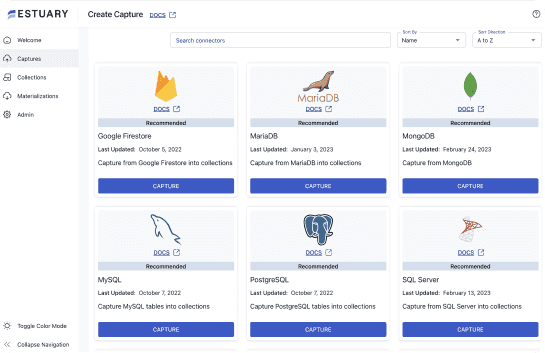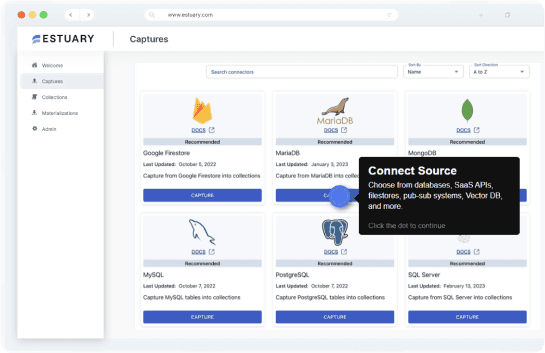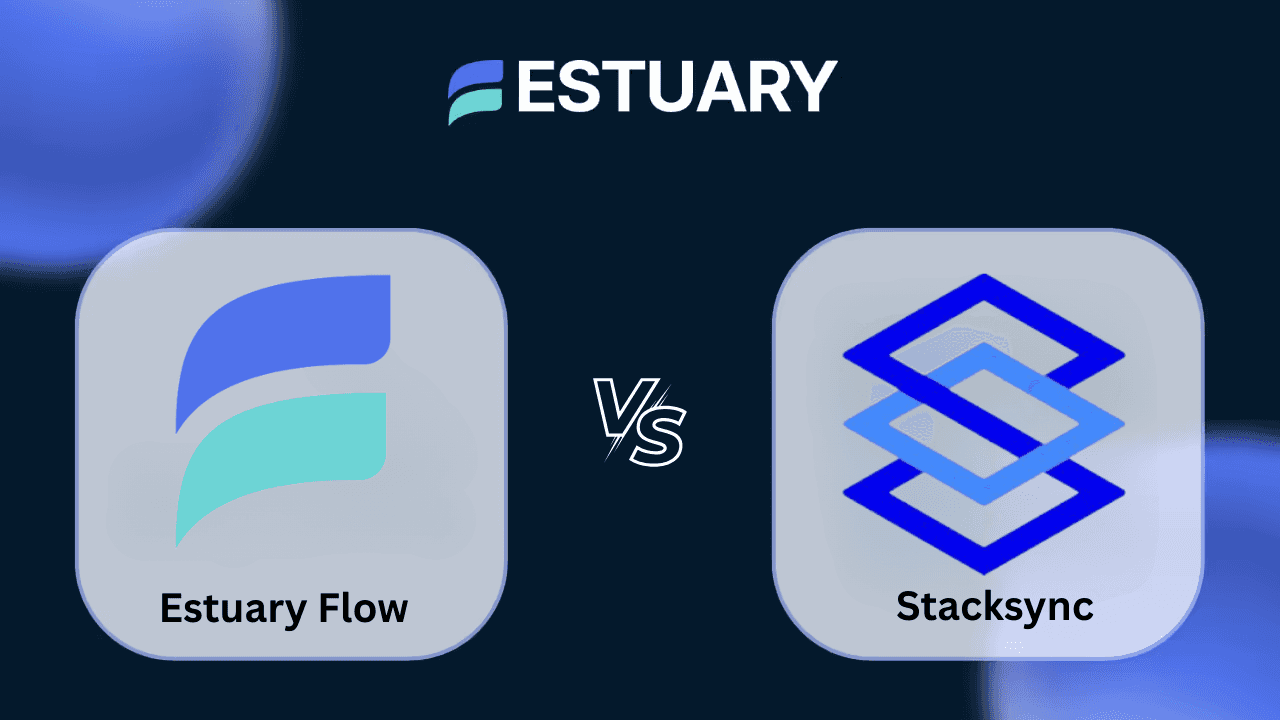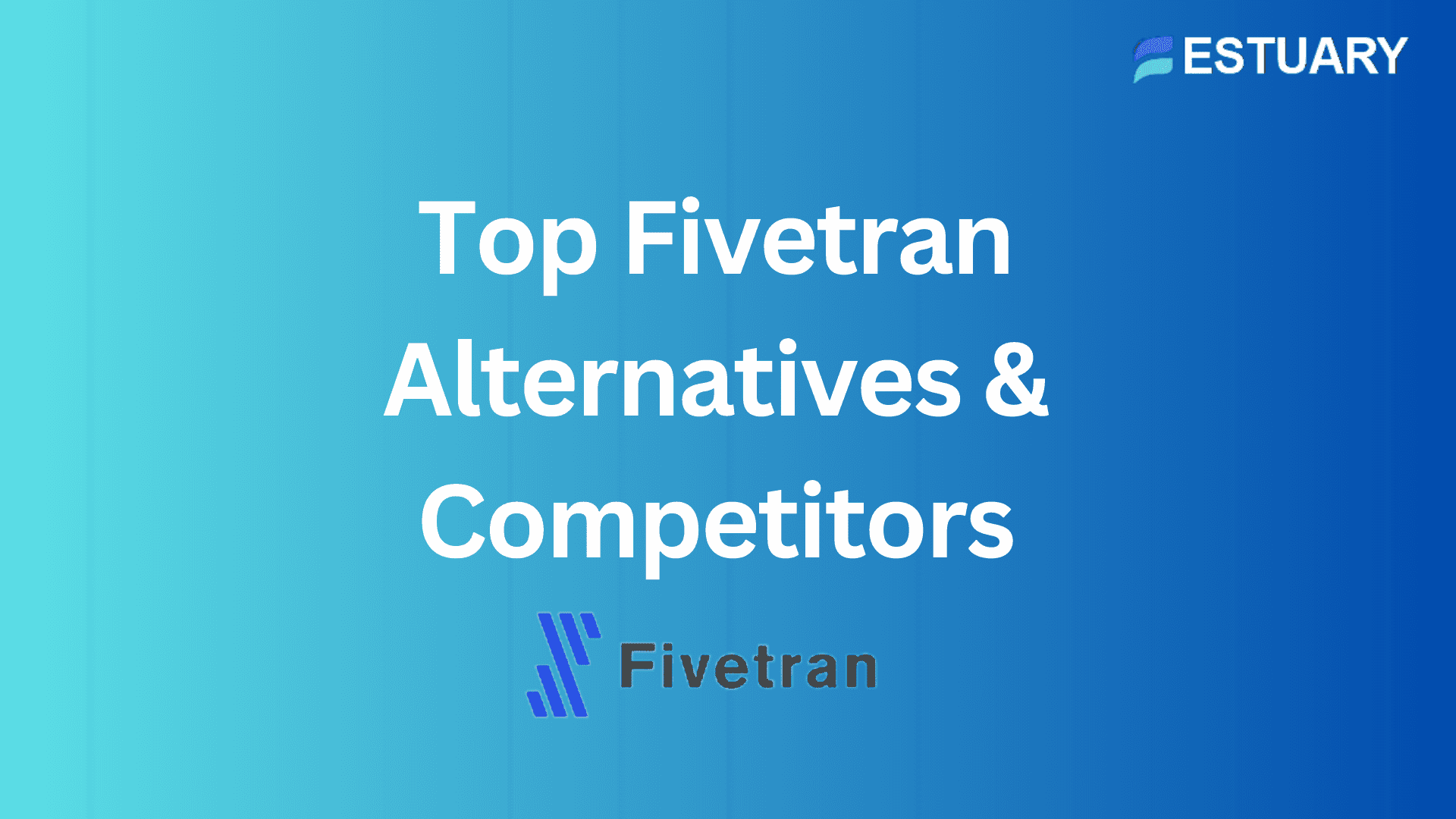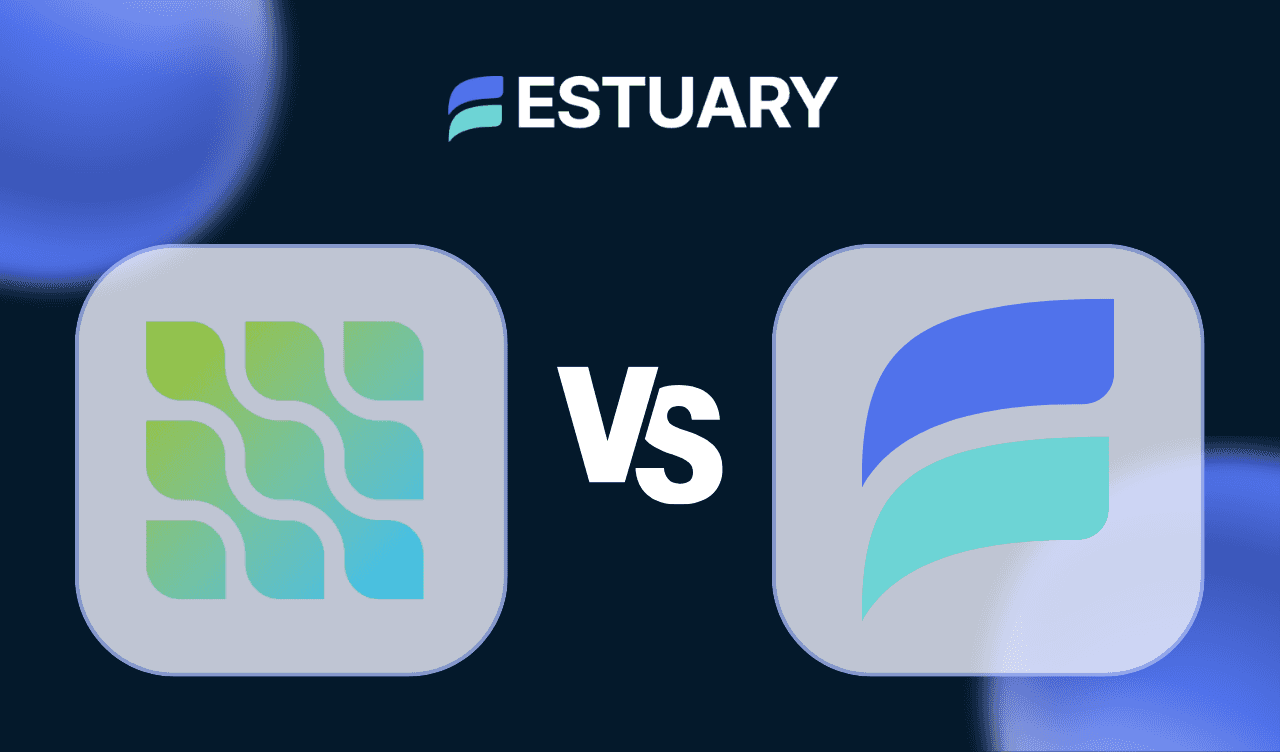
Two names often come up in this space: Estuary Flow and Stacksync. Both can move data in real time, though they emphasize different strengths.
Stacksync supports one-way and bi-directional syncs across CRMs, ERPs, databases, and warehouses, with no-code mapping, pro-code workflows, and automation to keep systems aligned.
Estuary Flow is a unified streaming data platform for CDC, streaming ETL, transformations, analytics, and AI. Beyond simple syncs, Flow provides exactly-once delivery, supports transformations in SQL and TypeScript, and offers deployment options including Public, Private, and BYOC.
In this guide, we compare Estuary Flow and Stacksync across features, performance, integrations, security, and pricing to help you decide which platform best fits your strategy.
Key Takeaways
- Both platforms support real-time integration. Stacksync supports one-way and bi-directional syncs across CRMs, ERPs, databases, and warehouses, while Estuary also powers CDC pipelines, streaming ETL, analytics, and AI workloads.
- Consistency you can rely on. Estuary provides exactly-once delivery for materializations. Stacksync emphasizes sub-second sync, conflict handling, and scaling to high data volumes.
- Transformations in motion. Estuary supports in-stream transformations using SQL and TypeScript; Stacksync provides no-code mapping plus pro-code workflows, SQL-based patterns, and automation for complex pipelines.
- Integration breadth. Estuary provides a wide connector catalog across databases, warehouses, streams, and SaaS, plus Kafka-API compatibility via Dekaf; Stacksync covers SaaS/CRM/ERP apps as well as databases and data warehouses.
- Deployment and compliance flexibility. Estuary supports Public, Private, and BYOC deployments with options like PrivateLink. Stacksync also offers BYOC and region choice with enterprise security and compliance features. Both platforms are designed to meet the needs of regulated industries.
- Pricing that scales predictably. Estuary uses a pay-as-you-go model based on data volume and task usage; Stacksync prices by active syncs and record volume, with workflow tiers. The right model depends on workload patterns.
Estuary Flow vs Stacksync: Comparison at a Glance
Although both Estuary Flow and Stacksync support real-time integration, they emphasize different strengths. Stacksync provides one-way and bi-directional syncs across CRMs, ERPs, databases, and warehouses, and includes both no-code automation and pro-code workflow capabilities. Estuary Flow is a streaming-first data platform that supports operational syncs as well as CDC pipelines, streaming ETL, analytics, and AI workloads, with in-stream transformations and flexible deployment options.
Capability | Estuary Flow | Stacksync |
| Primary focus | End-to-end real-time pipelines including CDC, streaming ETL, analytics, AI, and operational syncs | One-way and bi-directional sync across CRMs, ERPs, databases, and warehouses, with workflow automation |
| Consistency | Exactly-once delivery protocol with transactional recovery log for no duplicates or gaps | Sub-second latency and conflict handling at scale. |
| Latency | Millisecond updates across streaming pipelines and destinations | Sub-second sync across operational and analytical systems |
| Transformations | SQL and TypeScript derivations for advanced filtering, joins, and aggregations | No-code mapping plus pro-code workflows, SQL-native patterns, and automation for complex pipelines |
| Connectors | 200+ connectors across databases, warehouses, SaaS, and streaming systems, plus Kafka API compatibility (Dekaf) | Connectors across SaaS, CRMs/ERPs, databases (Postgres, Oracle, MySQL, MongoDB, SQL Server, MariaDB), and warehouses (Snowflake, BigQuery, MotherDuck) |
| Streaming & analytics | Kafka capture and materialization, Snowflake Snowpipe Streaming, AI/ML readiness | Real-time CDC pipelines into warehouses and databases, supporting analytics as well as SaaS sync |
| Deployment | Public SaaS, Private, and BYOC with PrivateLink and VPC peering | BYOC, region and cloud choice, with enterprise networking options |
| Compliance | SOC 2, HIPAA, GDPR with documented enterprise deployments | SOC 2 Type II, GDPR, HIPAA, ISO 27001 |
| Observability | OpenMetrics API for Prometheus/Datadog, detailed logs, and stats collections | Dashboards, log explorer, retention, and monitoring built into platform |
| Pricing | Pay-as-you-go based on data volume and tasks | Based on active syncs and record volume, with workflow tiers |
Want to understand the difference in action? Book a live demo with our team
Detailed Comparison: Estuary Flow vs Stacksync
1. Real-time sync and consistency
- Estuary Flow delivers exactly-once semantics with a transactional recovery log, ensuring no duplicates or gaps even during failures. This makes it especially strong for analytics and AI workloads where data correctness is critical.
- Stacksync emphasizes sub-second syncs, conflict handling, and the ability to scale to hundreds of millions of records. Its design focuses on maintaining high reliability and performance at enterprise scale.
2. Transformations and workflows
- Estuary Flow supports in-stream transformations with SQL and TypeScript. This gives developers the ability to join, filter, and enrich data as it flows, reducing the need for external transformation layers.
- Stacksync offers both no-code mapping and pro-code workflows, along with SQL-native access, replay/version control, and automation. This makes it accessible for business teams while providing depth for engineering use cases.
3. Connectors and integrations
- Estuary Flow provides a wide range of connectors across operational databases (Postgres, MySQL, MongoDB, SQL Server, Oracle, MariaDB), cloud warehouses (Snowflake, BigQuery, Databricks, Redshift), SaaS platforms (Salesforce, HubSpot, NetSuite, Shopify, and more), and streaming systems (Kafka, Pulsar). It also includes Kafka API compatibility through Dekaf, allowing Flow collections to be consumed like Kafka topics.
- Stacksync connects to SaaS and CRM systems such as Salesforce, HubSpot, and NetSuite, as well as databases like Postgres, Oracle, MySQL, MongoDB, SQL Server, and MariaDB, plus data warehouses including Snowflake, BigQuery, and MotherDuck.
4. Streaming and analytics support
- Estuary Flow is streaming-first, with features like Kafka capture and materialization, Snowflake Snowpipe Streaming, and real-time AI/ML data pipelines. These capabilities make it strong for low-latency analytics and streaming-first architectures.
- Stacksync also supports analytics use cases with real-time CDC pipelines into databases and warehouses. This makes it a fit for organizations looking to unify operational and analytical workflows.
5. Deployment and security
- Estuary Flow offers Public SaaS, Private deployments, and Bring Your Own Cloud (BYOC), along with options like PrivateLink and VPC peering for strict network control. These choices support industries with sensitive or regulated data.
- Stacksync provides BYOC, region and cloud choice, and enterprise networking features such as VPC peering, VPN, SSH tunneling, and SSO/SCIM.
6. Pricing approach
- Estuary Flow uses a pay-as-you-go model based on data volume and task usage, offering predictable scaling across small and large workloads.
- Stacksync charges based on the number of active syncs and record volume, with workflow tiers included. This model aligns with organizations managing many syncs or high record counts.
When to Choose Estuary Flow
- Analytics and BI teams that need reliable pipelines into warehouses like Snowflake, BigQuery, or Databricks. Estuary’s exactly-once delivery ensures accuracy for dashboards and reporting.
- AI and machine learning projects where data consistency directly impacts model performance. Estuary supports streaming-first architectures and in-stream transformations for real-time feature prep.
- Data engineers and developers who want code-level control. With SQL and TypeScript derivations, Estuary allows complex business logic to run inside the pipeline.
- Enterprises with strict compliance needs such as SOC 2, HIPAA, or GDPR. Estuary supports Public, Private, and BYOC deployments with PrivateLink for networking control.
- Teams planning for scale. Estuary’s pay-as-you-go model grows predictably across both operational syncs and analytical pipelines.
From startups to enterprises, companies are scaling faster with Estuary Flow. Read customer success stories
When to Choose Stacksync
- Business teams that want an easy way to sync CRMs, ERPs, databases, and warehouses using no-code or low-code setup, with pro-code workflows available when needed.
- One-way or two-way sync scenarios such as Salesforce ↔ Postgres or NetSuite ↔ Snowflake, ensuring updates flow reliably in both directions.
- Teams that need automation features like AI-driven field mapping, triggers, and replay/version control to streamline processes.
- Enterprises that require secure and compliant data syncs for operational use cases, including healthcare, finance, or government contexts.
Early-stage startup? Get $2,000 in free Estuary credits and start building pipelines today. Apply here
Conclusion
Choosing between Estuary Flow and Stacksync comes down to your organization’s priorities. Stacksync is well suited for enterprises that need one-way or two-way syncs across CRMs, ERPs, databases, and warehouses, combined with workflow automation and strong compliance. Estuary Flow is ideal if your strategy extends beyond syncs into streaming-first pipelines, analytics, and AI workloads where exactly-once consistency and in-stream transformations make a difference.
Both platforms can serve real-time needs at scale. Estuary Flow stands out with Snowpipe Streaming for Snowflake, Kafka-API compatibility, and deployment options including Public, Private, and BYOC. Stacksync stands out with its automation-first design, pro-code workflows, and broad coverage across operational systems and warehouses.
If you are evaluating your options, now is the right time to see how Estuary Flow can fit into your strategy.
👉 Get started with Estuary Flow for free or book a demo with our team to explore your use case.
FAQs
Which tool is better for analytics and AI?
How do Estuary Flow and Stacksync differ in pricing?

About the author
Team Estuary is a group of engineers, product experts, and data strategists building the future of real-time and batch data integration. We write to share technical insights, industry trends, and practical guides.

